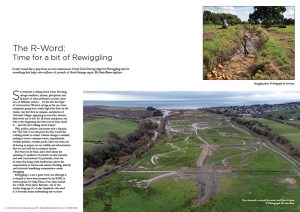It may sound like a quip from an over enthusiastic Strictly Come Dancing judge but Rewiggling may be something that helps save millions of pounds of flood damage repair. Dr Sam Rose explains.

So, everyone is talking about water. Flooding, sewage overflows, nitrates, phosphates and all kinds of other pollutants in rivers, from lots of different sources… it’s the new hot topic of conversation! We have sewage in the sea, water companies going bust, overly high river flows in the winter, very low flow in summer, and photos of ‘drowned’ villages appearing in reservoirs because their levels are so low. It’s all doom and gloom, but why is this happening and what can be done about it… and why am I talking about it here?
Well, politics, policies and money play a big part, but ‘The Vale’ is not the place for that, I leave the scathing attacks to others. Climate change is certainly making it worse—extreme events, unpredictable weather patterns, warmer ponds, lakes and rivers are all having an impact on our wildlife and infrastructure that was not built for an extreme climate.
But what can be done, and I don’t mean the spending of squillions of pounds on new concrete and steel constructions? In particular, what can be done that brings back biodiversity, allows the sequestration of carbon and reduces flooding, directly and obviously benefitting communities—enter rewiggling.
Rewiggling is a not a great word, but although it is claimed to have been invented by the RSPB, or made popular by Sadiq Khan, it has been around for a while. Even James Rebanks—he of the austere language of a Lakes shepherd—has used it. It basically means undertaking one or more interventions in, or adjacent to a stream or river so that it can regain a more natural course and ‘revert’ back to flowing as nature intended.
Why do we need it? What does it do? And why am I talking about it here? Well, over hundreds of years, thousands possibly in a few areas, streams and rivers have been straightened—canalised—and dredged by people. The straightening has been done for many reasons, including to, understandably, stop water from flooding agricultural land or infrastructure. There is no blame here, these practices have been encouraged for many years so as to help maintain food production which we all need, but with the changing climate comes increasing problems, such as pushing the flooding downstream.
Sometimes channels are straightened to be ‘neat’ or simple—if you look at straight hedges along fields, many will have ditches, dug (and kept clear) to neatly take the water away from the fields, but the speed at which they do that is frightening. Likewise with roadside ditches. Dredging can also be problematic. As well as for navigation, dredging is, again, often done to take more water away more quickly, to prevent flooding in one area, but again, it just pushes water downstream quicker, making problems elsewhere, as well as upsetting the balance of nature.
Most (although happily not all) of our brooks, streams, ditches, and rivers have been altered over time, which has led to many of the problems we are facing today. These actions negatively affect aquatic biodiversity and water quality, and increases flood risk in some areas, drought in others. Faster, deeper rivers are more difficult habitats for many species—particularly invertebrates—to thrive in, and so you not only lose the water life, but the amphibians, mammals, birds, bats and reptiles that feed on them, and so on up the food chain. Add this to the weirs, sluice gates, tunnels and culverts that affect our streams (yes a culvert under a road does technically carry a stream), it’s a wonder that we are not all under water in every storm, and that there is any life left in our rivers at all.
So, what’s to be done? One approach to tackling this is the rewilding approach—that is, letting nature take the lead, letting natural process act as they see fit. Nature is very good at knowing where water needs to go, it’s called gravity. Trying to ‘manage’ gravity is never going to end well, so we need to work with it.
As in some cases for land-based rewilding, to kick start the process of allowing a river to repair itself you need to intervene and give it a helping hand. This might include one or all of the following approaches:
1). making many small dams up in the headwaters, either naturally with beavers or by people making ‘leaky dams’. This slows the flow at the start of the rivers, often on higher land where more rain falls, and creates great habitats for wildlife, such as pools and scoured gravel spawning grounds in front of the dams;
2). blocking field drainage ditches, in-field drains and small streams, to allow rainwater to find its natural channel across the land—some people call this making a ‘stage zero’ stream. This is great for slowing the passage of water over the land, and creating new wetland habitats;
3). creating new channels alongside the existing ones and then diverting some water into these so that the overall flow slows and the water travels over a wider surface area, creating new meanders and better habitat for wildlife;
4). raising the riverbed levels with woody or rocky debris so that when the water levels go up, it pushes it out onto the floodplain (the clue is in the name, floodplains are called that because they flood—no one should be surprised by that). The excess water is captured there in ‘scrapes’ (shallow ponds) or larger ponds and held for a while.
All these approaches, and many more, create ‘friction’ in the water system, slowing, altering and allowing the rivers to behave more naturally. They also have multiple benefits, such as trapping sediment washed into the river from ploughed fields, capturing carbon in peaty wetlands and sediment, and filtering the nitrates, phosphates and other chemicals out of the water. Slowing the flow and creating pools and ponds is not only also good for new wetland habitats, but also they reduce the chance of flooding downstream, and maintain a higher flow level in times of drought, better for farm animals as well as for wildlife.
This is a complex and challenging subject, and I have, like the water boatmen, just skimmed the surface. There is a lot to explore online, so please dive in, and like rewilding, rewiggling is not for everywhere—our landscape is too developed for that—but with the right intervention in the right place, and with landowner and community support, it can be very, very effective… so rewiggle away!




